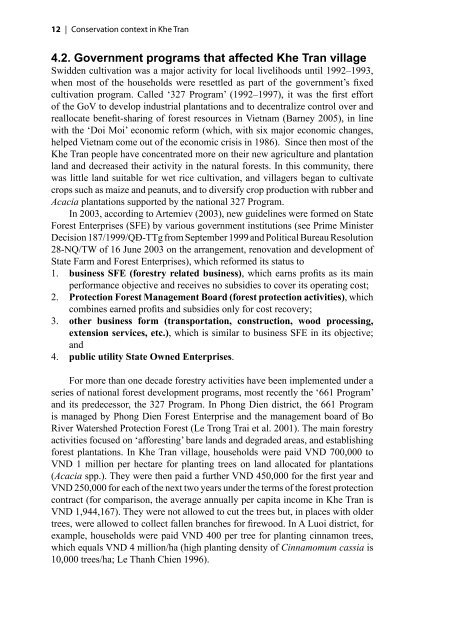English 2.28MB - Center for International Forestry Research
English 2.28MB - Center for International Forestry Research
English 2.28MB - Center for International Forestry Research
You also want an ePaper? Increase the reach of your titles
YUMPU automatically turns print PDFs into web optimized ePapers that Google loves.
| Conservation context in Khe Tran<br />
4.2. Government programs that affected Khe Tran village<br />
Swidden cultivation was a major activity <strong>for</strong> local livelihoods until 1992–1993,<br />
when most of the households were resettled as part of the government’s fixed<br />
cultivation program. Called ‘327 Program’ (1992–1997), it was the first ef<strong>for</strong>t<br />
of the GoV to develop industrial plantations and to decentralize control over and<br />
reallocate benefit-sharing of <strong>for</strong>est resources in Vietnam (Barney 2005), in line<br />
with the ‘Doi Moi’ economic re<strong>for</strong>m (which, with six major economic changes,<br />
helped Vietnam come out of the economic crisis in 1986). Since then most of the<br />
Khe Tran people have concentrated more on their new agriculture and plantation<br />
land and decreased their activity in the natural <strong>for</strong>ests. In this community, there<br />
was little land suitable <strong>for</strong> wet rice cultivation, and villagers began to cultivate<br />
crops such as maize and peanuts, and to diversify crop production with rubber and<br />
Acacia plantations supported by the national 327 Program.<br />
In 2003, according to Artemiev (2003), new guidelines were <strong>for</strong>med on State<br />
Forest Enterprises (SFE) by various government institutions (see Prime Minister<br />
Decision 187/1999/QĐ-TTg from September 1999 and Political Bureau Resolution<br />
28-NQ/TW of 16 June 2003 on the arrangement, renovation and development of<br />
State Farm and Forest Enterprises), which re<strong>for</strong>med its status to<br />
1. business SFE (<strong>for</strong>estry related business), which earns profits as its main<br />
per<strong>for</strong>mance objective and receives no subsidies to cover its operating cost;<br />
2. Protection Forest Management Board (<strong>for</strong>est protection activities), which<br />
combines earned profits and subsidies only <strong>for</strong> cost recovery;<br />
3. other business <strong>for</strong>m (transportation, construction, wood processing,<br />
extension services, etc.), which is similar to business SFE in its objective;<br />
and<br />
4. public utility State Owned Enterprises.<br />
For more than one decade <strong>for</strong>estry activities have been implemented under a<br />
series of national <strong>for</strong>est development programs, most recently the ‘661 Program’<br />
and its predecessor, the 327 Program. In Phong Dien district, the 661 Program<br />
is managed by Phong Dien Forest Enterprise and the management board of Bo<br />
River Watershed Protection Forest (Le Trong Trai et al. 2001). The main <strong>for</strong>estry<br />
activities focused on ‘af<strong>for</strong>esting’ bare lands and degraded areas, and establishing<br />
<strong>for</strong>est plantations. In Khe Tran village, households were paid VND 700,000 to<br />
VND 1 million per hectare <strong>for</strong> planting trees on land allocated <strong>for</strong> plantations<br />
(Acacia spp.). They were then paid a further VND 450,000 <strong>for</strong> the first year and<br />
VND 250,000 <strong>for</strong> each of the next two years under the terms of the <strong>for</strong>est protection<br />
contract (<strong>for</strong> comparison, the average annually per capita income in Khe Tran is<br />
VND 1,944,167). They were not allowed to cut the trees but, in places with older<br />
trees, were allowed to collect fallen branches <strong>for</strong> firewood. In A Luoi district, <strong>for</strong><br />
example, households were paid VND 400 per tree <strong>for</strong> planting cinnamon trees,<br />
which equals VND 4 million/ha (high planting density of Cinnamomum cassia is<br />
10,000 trees/ha; Le Thanh Chien 1996).

















